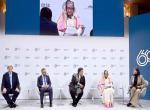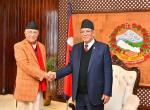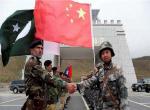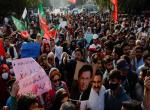Riaz Mohammed Khan’s book “Afghanistan and Pakistan” adds to the already numerous books available on the shelves on the linked Afghanistan-Pakistan situation. The Taliban-takeover of Afghanistan, the 9/11 terror attack that provoked US military intervention leading to Taliban’s ouster from power, US failure to consoildate its success because of the distraction of the Iraq war, the resurgence of the Taliban and Pakistan’s collusion in this, have all been analysed by diverse authors from different perspectives. So when a new book appears it has to offer more than a pastiche of facts, views and analyses that the reader is already familiar with.
The author, who was Pakistan’s Foreign Secretary from 2005 to 2008, offers an insider’s perspective on the subject. His book is not a work of scholarship based on “rigorous or extensive” research, as the author avows in the introduction. He offers, as he says, a “broad-brush treatment of events”, weaving “personal experiences, perspectives, and evaluation into the larger narrative”, derived from his various assignments in the Pakistani Foreign Office.
A former Pakistani diplomat who has officially handled Afghanistan related issues, analysed them on file and in internal discussions, and contributed in some measure to policy making, can be expected to adhere largely to the standard Pakistani view that we know. While this undercurrent in not absent from the book, the sobriety with which the author expounds his views and the penetrating reflections he makes on many aspects of Pakistani thinking and policies is striking.
The first part of the book covers the post-Soviet withdrawal phase of the Afghanistan conflict from 1989 to 1995, the advent of the Taliban from 1996 to 2001, the developments in Afghanistan post-9/11, with the interests and concerns of the external powers examined in a separate chapter. The second part deals with the Pakistan context of the Afghan situation, with focus on the grave challenge of religious militancy and extremism that the country faces. The intellectual crisis and weak governance in Pakistan is examined with great acuity in chapter 6 of the book. The book ends with the author’s “Conclusions” that pinpoint the mistakes made and opportunities missed by western powers in dealing with the developments in Afghanistan at critical moments. This section assesses the exit strategy, the prospects of stabilizing Aghanistan, the reconciliation and reconstruction agenda and the challenge of rebuilding of the Afghan National Army. The December 10 review of the US counter-insurgency strategy is examined, recommendations are made for an Afghnistan-Pakistan modus vivendi, the conundrum of US-Pakistan relations is looked at, with a glance at the expectations of Pakistan whose dearth of political and intellectual leadership is highlighted.
The author does not believe that Pakistan bears the major responsibility for the mess in Afghanistan, though he does expose the disruptive aspects of its policies and actions. The Pakistan Army and the ISI, he acknowledges, have supported the Afghan insurgents at the highest levels, and at the middle levels have admired their piety and intransigence. He rejects, however, the idea that the ISI created the Taliban, arguing that they were a phenomenon waiting to happen after 10 years of Soviet occupation and 5 years of internecine conflict, with President Zia’s islamization policies, the mushrooming of madrassahs and muslim charities from the Gulf under the influence of Wahhabi and Deobandi ideology acting as catalysts. He concedes that in the 1990s the Pakistanis did believe that the Taliban offered the best hope for stabilization as they drew strength from ethnic Pashtuns straddling the border, and that once settled in power they would become more moderate. Hence, Pakistan favoured engaging the Taliban before and after 9/11, but the international community isolated them in the 1990s because of their human rights record, treatment of women, the bombing of the US embassies in Kenya and Tanzania embassies and the Al Qaida connection, pushing the Taliban therefore towards greater dependence on foreign elements.
After 9/11 Pakistan’s earlier policy of supporting the Taliban was of course in shambles, with the Northern Alliance in Kabul and Al Qaida and Taliban elements moving into FATA. President Musharraf pressed the US not to allow a government in Kabul unfriendly to Pakistan and pleaded for the inclusion of some moderate Taliban elements in it, but the Bonn Agreement excluded the Taliban and all hardline Mujaheddin groups, which, for the author, was a mistake.
The author argues that Pakistan is not responsible for the post 9/11 resurgence of the Taliban. They had been routed but not destroyed. Later developments, according to the author, including America’s war on Iraq which strengthened the Al Qaida and deflected US attention away from Afghanistan, lack of economic support for Afghanistan after Bonn and the meagre results of the Tokyo Donors Conference that only helped to foster the opium economy, the ineffectiveness of aid programmes, poor governance, the absence of government at local levels, the neglect of agriculture as a result, the non-Pashtun character of the Afghan National Army, the perception that the Taliban were fighting for Pashtun rights, the overweening US and UN presence that hurt President Karzai’s image and no accretion to his authority after the 2004 Presidential election, all contributed to the steady resurgence of the Taliban.
Afghanistan holds Pakistan responsible for this development as the insurgents operate from Pakistani territory. Pakistan, however, believes it is a victim of the unsettled situation in Afghanistan. The author refutes the widely made charge that because Pakistan views the Taliban as a long term asset for recovering political influence in Kabul, it is reluctant to act against the group. Pakistan, in his view, can be blamed for half-hearted cooperation but not such calculation. He sees the conflict as fundamentally an Afghan issue. However, with US counter-insurgency efforts failing to produce wanted results, Pakistan has come under greater pressure, with the drone attacks exacerbating US-Pakistan tensions. Lack of trust now marks the military relations between the two countries, with a growing disconnect between the US and Pakistan perceptions and approaches at the operational level.
The author makes the familiar argument that Pakistan does not target the Afghan Taliban as they do not fight Pakistani troops or carry on acts of violence within the country, that Pakistan’s primary concern is the Pakistani Taliban and that apart from Pakistani empathy with the Taliban, Pakistan has limited capacity to interdict and control them. According to him, Pakistan has been soft on the Haqqanis and Mullah Nazir with a view to squeezing Baitullah Masud. However, even as suicide bombings in Pakistan are rising, the US asks Pakistan to do more. The author denies any double dealing by Pakistan; even pro-US elements in Pakistan, according to him, are disappointed that the US does not see the complexity of the problem facing Pakistan. The general feeling in Pakistan is that the war on terror is not that of Pakistan and that Pakistan is being used as hired help. The author tries to persuade but fails to convince.
Looking ahead at prospects of stability in Afghanistan, the author sees the US military presence in Afghanistan a problem as well as a solution. The Afghan population is tired of violence and conflict. If the US forces begin withdrawing and other improvements on the ground occur, the rationale for fighting would weaken. Hearts and minds cannot be won by intensification of military efforts. But then, until the Afghan National Security Forces(ANSF) are built, the militancy cannot be pacified.
The chapter on the role of external powers provides some useful insights into the thinking of China and Iran as shared with the Pakistanis. The author sees the rivalry between India, Iran and Pakistan as a source of problems. While recognizing that Pakistan and Afghanistan cannot be detached because of intense informal linkages between the two countries, he sees Pakistan’s posture of treating Aghanistan as its backyard as being deeply offensive to the Afghans. He is scornful of the concept of strategic depth that has animated the thinking of the Pakistani military towards Afghanistan and finds Pakistani pleas for a friendly government in Kabul politically unwarranted as Afghanistan has never posed a conventional military threat to Pakistan.
Backing the Taliban is no longer a viable option for Pakistan today, he says, as that would give the Pakistani Taliban more strength. The author realistically notes that the Taliban had earlier risen to power in Afghanistan because of unique developments, but today opposition to them is strong, Afghanistan is not the war torn country of the mid-1990s and the non-Pashtuns are not willing to accept Taliban rule. Pakistan can at best exert local influence in a fragmented Afghanistan.
It is difficult to believe that, as the author claims, Pakistan will not pursue factional politics in Afghanistan to balance Indian influence. General Musharraf, who no doubt reflects sentiments prevailing in the Pakistani military, still proclaims at all forums that India is in close alliance with the erstwhile Northern Alliance groups and that the Afghan intelligence cooperates with R&AW in Pakistani frontier areas and Balochistan. The author is even less persuasive when he argues that in Pakistan’s soft environment(!) contacts between the Afghan Taliban and retired military officials do exist but the latter are not acting in accordance with official policy. According to him, a stable Afghanistan would require a balance between different groups and not domination by any particular one.
India’s interest in Afghanistan is not presented by the author with the usual Pakistani distortions. He sees India maintaining good relations with the Northern Alliance and building goodwill among the Pashtuns. He believes, rightly, that some understanding between India and Pakistan could have a positive impact on Afghanistan, recalling that in 2006 India had approached Pakistan to help Afghanistan settle down but Pakistan took it as a bid to raise the transit issue and did not respond.
For Iran the Taliban are, the author recognizes, a challenge because of their salafist ideology The Iranians recall the killing of their personnel by Pakistani anti-shia elements amongst the Taliban. Iran has concern about US support for Iranian dissident groups. They haven’t made Pak-US military co-operation an issue in Pakistan-Iran bilateral relations. The author considers the Iranian policy pragmatic and circumspect.
The author is critical of Saudi Arabia’s role in financing madrassahs in Pakistan and Afghanistan with salafist ideology and making no effort to reverse this policy. The Russians cannot overlook the fact that the Taliban were the only government to recognize Chechenya. The author has detected no concern in Russia about US bases in Afghanistan. China has expressed no adverse reaction to US military intervention in Afghanistan either. However, beyond curbing terrorism and religious extremism, China would not want a consolidation of US presence in Afghanistan. China has shown no anxiety in bilateral discussions with Pakistan about Nato presence in Afghanistan or its use of Pakistani faciities. In the author’s view tension between US and Pakistan is a liability for China, but he does not explain why.
The chapter on Pakistan in the book is possibly the most revealing as the author is clinical in dissecting Pakistan’s shortcomings and failings. An Indian observer making similar assessment of the state of affairs in Pakistan would have been accused of a deep anti Pakistan bias. The author confirms all the negative Indian perceptions of Pakistan. For him, the challenge in Pakistan is a combination of religious motivation, madrassah education, Afghanistan and Kashmir related rhetoric and official patronage for religious militancy. The Pakistani sunni groups have participated in Taliban campaigns. The LeT has been involved in the Kashmir insurgency, but while the group has avoided violence in Pakistan it has fostered an environment of intolerance in Pakistan.
In the 90s sectarian violence was seen as a bane, but jihadi groups despite their sectarian affiliations were cossetted by the military, while the Nawaz Sharif government, whose supporters in the business community who believe in Islamization, saw jihadi groups with equanimity. Benazir Bhutto did not take on the religious constituency, Musharraf was cautious not to touch the army’s sensitivities on Kashmir and ruffle orthodoxy.
There is ambiguity in Pakistan towards the threat of religious extremism, he notes. A lot of ground has been ceded to conservative islamic thinking and to religious parties. Musharraf’s concept of enlightened moderation was simplistic. He failed to achieve madrassah and mosque reforms and the banning militant sectarian groups. The attempt to revise the blasphemy laws created some anxiety amongst the ranks, which points to the spread of extremist thinking in the lower echelons of the military.
Pakistan shows a strong trans-national impulse rooted in the Ummah, with jihadi groups showing no respect for national boundaries, including in Afghanistan says the author. The Tableeghi Jamat has created a dense religious emvironment. The influence of the jamaat e islami, religious vigilantism, politicisation of education has stifled culture. Zia ul Haque policy of islamisation and the Saudi inspired salafist thinking has taken root.
The author is candid about the backing the jihadi groups have received from the Pakistani military with a view to compelling india to negotiate on Kashmir. The Pakistani military has believed that the liberation struggle in Kashmir could be successfully supported. The ISI was deeply involved with Kashmir groups. Pakistan is in permanent confrontation with India. Mistrust of india, he says ominously, is part of Pakistan army’s institutional culture which can be softened but not changed.
The ideas of security, religiosity and patriotism suit the military. There is aggressive patriotism at retired mid level military and civilian official level. Jihad, piety and faith is the motto of army, The ranks of the armed forces are not immune to extremism. Hawkish views on security and foreign relations assosciated with ISI are quite common in the Foreign offfice and the civilan establishment because of many bouts of military rule in Pakistan.
The author confirms the many syndromes his country suffers from. Pakistan has a beseiged mentality, with conspiracy theories rampant. It externalizes blame, blaming India and the US for supporting the Taliban, even Mahsud, as well as suicide bombings. Pakistan resorts to denial with facility, saying the Kashmir struggle is indigenous, denying the presence of Mullah Omar or the Al Qaida in Pakistan. There is a streak of anti- modernity in popular thinking, an antipathy towards secularism, modernization and liberalism, a tendency to condone the Al Qaida and Taliban’s excesses as a consequence of the US presence in Afghanistan.
The author’s conclusions cover the past and the future. Many of his recommendations for the future are eminently sensible, even if his analysis of the past can be questioned in parts.
Published in The Book Review Issue - March 2012








Post new comment